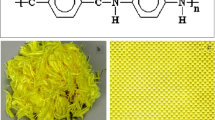For successful employment of technology in many fields, it is essential to have materials that possess high electrical conductivity. The electrical conductivity of polymeric materials depends on many factors, primarily on hygroscopicity, structure and chemical constitution, and presence of some substances on its surface. The investigation is conducted on the structure and properties of Armos para-aramid fibre in the context of potentials for subsequent modification for imparting electrical conductivity to it.





Similar content being viewed by others
References
A. V. Volokhina, Khim. Volokna, No. 2, 14-21 (2001).
K. E. Perepelkin, Structure and Properties of Fibres [in Russian], Khimiya, Moscow (1985), p. 208.
A. A. Konkin, G. I. Kudryavtsev, et al., Heat- and Fire-Resistant and Incombustible Fibres [in Russian], edited by A. A. Konkin, Khimiya, Moscow (1978), p. 424.
L. S. Gal’braikh, Sorosovskii Obrazovat. Zhurn., No. 3, 42-48 (1993).
K. E. Perepelkin (editor), Manufacture and Application of Fibres Having Specific Properties [in Russian], NIITEKhim, Mytishchy (1980), p. 110.
G. E. Krichevskii, Nano-, Bio-, and Chemical Technologies and Manufacture of A new Generation of Fibres, Textiles, and Clothing [in Russian], Izvestiya, Moscow (2011), p. 526.
G. I. Kudryavtsev, Reinforcing Chemical Fibres for Composites [in Russian], Khimiya, Moscow (1992), p. 329.
B. B. Bobovich, Nonmetallic Structural Materials: A Textbook for Vuz (Higher Educational Institutions) [in Russian], MGIU, Moscow (2009), p. 383.
N. N. Machalaba, Khim. Volokna, No. 3, 3-10 (1999).
K. E. Perepelkin, Khim. Volokna, No.2, 22-29 (2001).
N. N. Machalaba, Khim. Volokna, No. 5, 17-22 (2000).
S. I. Banduryan, Khim. Volokna, No. 6, 41-43 (2002).
K. E. Perepelkin , Khim. Volokna, No.1, 34-38 (1995).
V. A. Platonov, Khim. Volokna, No. 4, 36-38 (2003).
V. V. Safonov, Protective Polymeric Coatings and Materials, Pt. 3. Protection of Polymers and Paints from Photoirradiation [in Russian], MGUDT, Moscow (2015), p. 217.
H. S. Nalwa (editor), Handbook of Conducting Polymers, New York (1997), p. 1120.
E. A. Sergeeva and K. D. Kostina, Vestn. Tekhnologich. Univ., 18, No. 14, 124-125 (2015).
A. R. Bunsell (editor), Handbook of Tensile Properties of Textile and Technical Fibres, Woodhead Publishing, Cambridge (2009), p. 696.
Author information
Authors and Affiliations
Corresponding author
Additional information
Translated from Khimicheskie Volokna, No. 6, 82-84, November-December, 2018
Rights and permissions
About this article
Cite this article
Sapozhnikov, S.V., Gubin, S.P. & Safonov, V.V. Investigation of Structure and Properties of Armos Para-Aramid Fibre in the Context of Potentials for its Subsequent Modification. Fibre Chem 50, 562–565 (2019). https://doi.org/10.1007/s10692-019-10031-6
Published:
Issue Date:
DOI: https://doi.org/10.1007/s10692-019-10031-6




